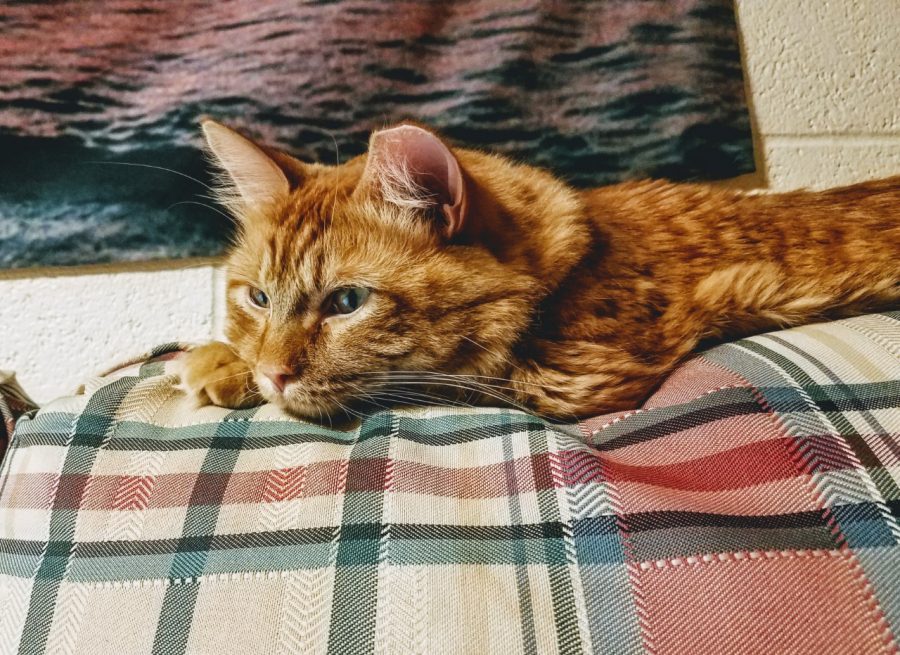Animals offer physical, emotional support on campus to students
Arthur is one of several animals allowed in the dorms.
Pets are generally not allowed in Calvin’s dorms or campus buildings. However, thanks to Calvin Disability Services, those struggling with mental and physical conditions can be provided with a furry companion.
Junior Katie Van Drie, whose service dog Kenai can be seen walking alongside her to class, is one such student. Kenai was specially trained to bond with her and requires a great deal of focus to do his job. Van Drie has arrhythmia, a condition that causes an irregular heartbeat, and anemia, which means she has fewer red blood cells in her system than normal. These conditions combined make it more likely for Van Drie to pass out on occasion. Kenai is specially trained to monitor her heart rate and cortisol levels with his senses of hearing and smell.
“If [my heart rate] goes too low, he’ll actually push the backs of my knees to have me sit down while I wait for it come back up,” Van Drie explained. “He’s also trained to detect different cortisol levels in my blood, because your body gives off certain scents when you have a fluctuation in those. So he’s trained in what’s called ‘anxiety aid alert and response’ … On occasion, if he senses that my breathing changes or if I’m bobbing my knee up and down, he will do what is called DPT, or Deep Pressure Therapy.”
Kenai wears a vest marking him as a trained service animal, which allows him to accompany Van Drie to class and anywhere else he might not otherwise be allowed. It also helps others know that he’s not to be petted or otherwise distracted from doing his job of keeping Van Drie safe.
There is, however, a second type of animal allowed on Calvin’s campus: an emotional support animal (ESA). While these animals aren’t formally trained, they can still help those dealing with mental illness. Junior Abby Poirier, a fellow Chimes writer, who has been diagnosed with anxiety and depression, comes back to her dorm room to find her cat Arthur waiting for her. The fluffy orange feline contentedly sits in her lap and purrs while she runs her fingers through his fur to recover from a long day. “The purpose of an ESA is just to provide comfort and companionship for people,” Poirier says, “because sometimes it’s hard for people to relate, but animals always do.”
Arthur is a relatively new addition to Poirier’s life, as she had been receiving the same sort of support from her cat at home. When she started living in the dorms instead of attending school from home, she asked her doctor about getting a cat in her dorm. She received a note from her doctor, and Arthur has been an additional resident with Proirier for almost a month now. He doesn’t wear an official vest, the go-to mark of a service animal. This, Poirier explained, is because ESAs require no official training. In fact, Arthur was originally a street cat Poirier adopted from a shelter.
“It’s basically just having a pet that you’ve bonded with, but for medical reasons you’re able to have them live with you in any housing,” she elaborated. “And basically just having that letter from your doctor is the proof that you need to be able to have that animal with you in any housing. So basically if I went to rent an apartment, even if they had a no-cats policy, I could show them the letter and say, ‘For medical reasons.’”
While Arthur is allowed free reign in Proirier’s dorm room, he has limits. ESAs, unlike officially trained medical support animals, are not allowed in classrooms. While Arthur is well-behaved, Calvin doesn’t let just any animal on campus.“If he was not friendly and posed a threat to other people… he would get kicked out, so there’s, like, rules,” Poirier explained. “They have to be friendly; they have to be well-trained.”
Arthur is incredibly popular on her floor, 1st KHvR, and Poirier’s floormates frequently stop in to pet him. Poirier thinks this isn’t just indicative of Arthur’s likability, but of the general college stress that every student needs a break from. “College is really stressful,” she observes. “It’s really easy to just be so stressed out that it’s hard to just manage your life… I feel like there should be more animals on campus, because we’re all so stressed,” she said.
Junior Rachel Hubka agrees with Poirier, as she has her own ESA cat. She observes that many people have pets back home that they miss who were a great help in keeping them happy. “It’s why when they bring dogs (and that one cat) into Johnny’s during finals, tons of people flock to them,” she observes. “Animals… are great at relieving stress and calming anxiety.”











